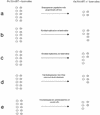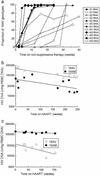Heterogeneous clearance rates of long-lived lymphocytes infected with HIV: intrinsic stability predicts lifelong persistence
- PMID: 12684537
- PMCID: PMC153639
- DOI: 10.1073/pnas.0736332100
Heterogeneous clearance rates of long-lived lymphocytes infected with HIV: intrinsic stability predicts lifelong persistence
Abstract
Viral replication and latently infected cellular reservoirs persist in HIV-infected patients achieving undetectable plasma virus levels with potent antiretroviral therapy. We exploited a predictable drug resistance mutation in the HIV reverse transcriptase to label and track cells infected during defined intervals of treatment and to identify cells replenished by ongoing replication. Decay rates of subsets of latently HIV-infected cells paradoxically decreased with time since establishment, reflecting heterogeneous lymphocyte activation and clearance. Residual low-level replication can replenish cellular reservoirs; however, it does not account for prolonged clearance rates in patients without detectable viremia. In patients receiving potent antiretroviral therapy, the latent pool has a heterogeneous and dynamic composition that comprises a progressively increasing proportion of stable lymphocytes. Eradication will not be achieved with complete inhibition of viral replication alone.
Figures



Similar articles
-
Reservoirs for HIV-1: mechanisms for viral persistence in the presence of antiviral immune responses and antiretroviral therapy.Annu Rev Immunol. 2000;18:665-708. doi: 10.1146/annurev.immunol.18.1.665. Annu Rev Immunol. 2000. PMID: 10837072 Review.
-
Pilot study of a combination of highly active antiretroviral therapy and cytokines to induce HIV-1 remission.J Acquir Immune Defic Syndr. 2001 Jan 1;26(1):44-55. doi: 10.1097/00126334-200101010-00006. J Acquir Immune Defic Syndr. 2001. PMID: 11176268 Clinical Trial.
-
HIV-1 residual viremia and proviral DNA in patients with suppressed plasma viral load (<400 HIV-RNA cp/ml) during different antiretroviral regimens.Curr HIV Res. 2008 May;6(3):261-6. doi: 10.2174/157016208784325010. Curr HIV Res. 2008. PMID: 18473790
-
HIV-1 DNA and RNA kinetics in primary HIV infection.J Biol Regul Homeost Agents. 2002 Jan-Mar;16(1):49-52. J Biol Regul Homeost Agents. 2002. PMID: 12003174
-
Modeling HIV persistence, the latent reservoir, and viral blips.J Theor Biol. 2009 Sep 21;260(2):308-31. doi: 10.1016/j.jtbi.2009.06.011. Epub 2009 Jun 17. J Theor Biol. 2009. PMID: 19539630 Free PMC article. Review.
Cited by
-
HIV-1 diversity in viral reservoirs obtained from circulating T-cell subsets during early ART and beyond.PLoS Pathog. 2024 Sep 18;20(9):e1012526. doi: 10.1371/journal.ppat.1012526. eCollection 2024 Sep. PLoS Pathog. 2024. PMID: 39292732 Free PMC article.
-
ORC1 enhances repressive epigenetic modifications on HIV-1 LTR to promote HIV-1 latency.J Virol. 2024 Aug 20;98(8):e0003524. doi: 10.1128/jvi.00035-24. Epub 2024 Jul 31. J Virol. 2024. PMID: 39082875
-
Mosaic vaccine-induced antibody-dependent cellular phagocytosis associated with delayed HIV-1 viral load rebound post treatment interruption.Cell Rep. 2024 Jun 25;43(6):114344. doi: 10.1016/j.celrep.2024.114344. Epub 2024 Jun 8. Cell Rep. 2024. PMID: 38850529 Free PMC article.
-
Ponatinib Represses Latent HIV-1 by Inhibiting AKT-mTOR.Antimicrob Agents Chemother. 2023 Jun 15;67(6):e0006723. doi: 10.1128/aac.00067-23. Epub 2023 May 22. Antimicrob Agents Chemother. 2023. PMID: 37212670 Free PMC article.
-
Genotypic Resistance Testing of HIV-1 DNA in Peripheral Blood Mononuclear Cells.Clin Microbiol Rev. 2022 Dec 21;35(4):e0005222. doi: 10.1128/cmr.00052-22. Epub 2022 Sep 14. Clin Microbiol Rev. 2022. PMID: 36102816 Free PMC article. Review.
References
-
- Wei X, Ghosh S K, Taylor M E, Jonson V A, Emini E A, Deutsch P, Lifson J D, Bonhoeffer S, Nowak M A, Hahn B H, et al. Nature. 1995;373:117–122. - PubMed
-
- Ho D D, Neumann A U, Perelson A S, Chen W, Leonard J M, Markowitz M. Nature. 1995;373:123–126. - PubMed
-
- Perelson A S, Essunger P, Cao Y, Vesanen M, Hurley A, Saksela K, Markowitz M, Ho D D. Nature. 1997;387:188–191. - PubMed
-
- Cavert W, Notermans D W, Staskus K, Wietgrefe S, Zupancic M, Gebhard K, Henry K, Zhang Z Q, Mills R, McDade H, et al. Science. 1997;276:960–964. - PubMed
Publication types
MeSH terms
Substances
Grants and funding
LinkOut - more resources
Full Text Sources
Other Literature Sources
Medical

